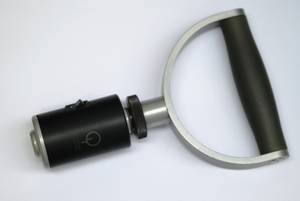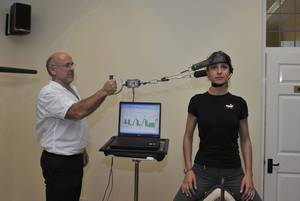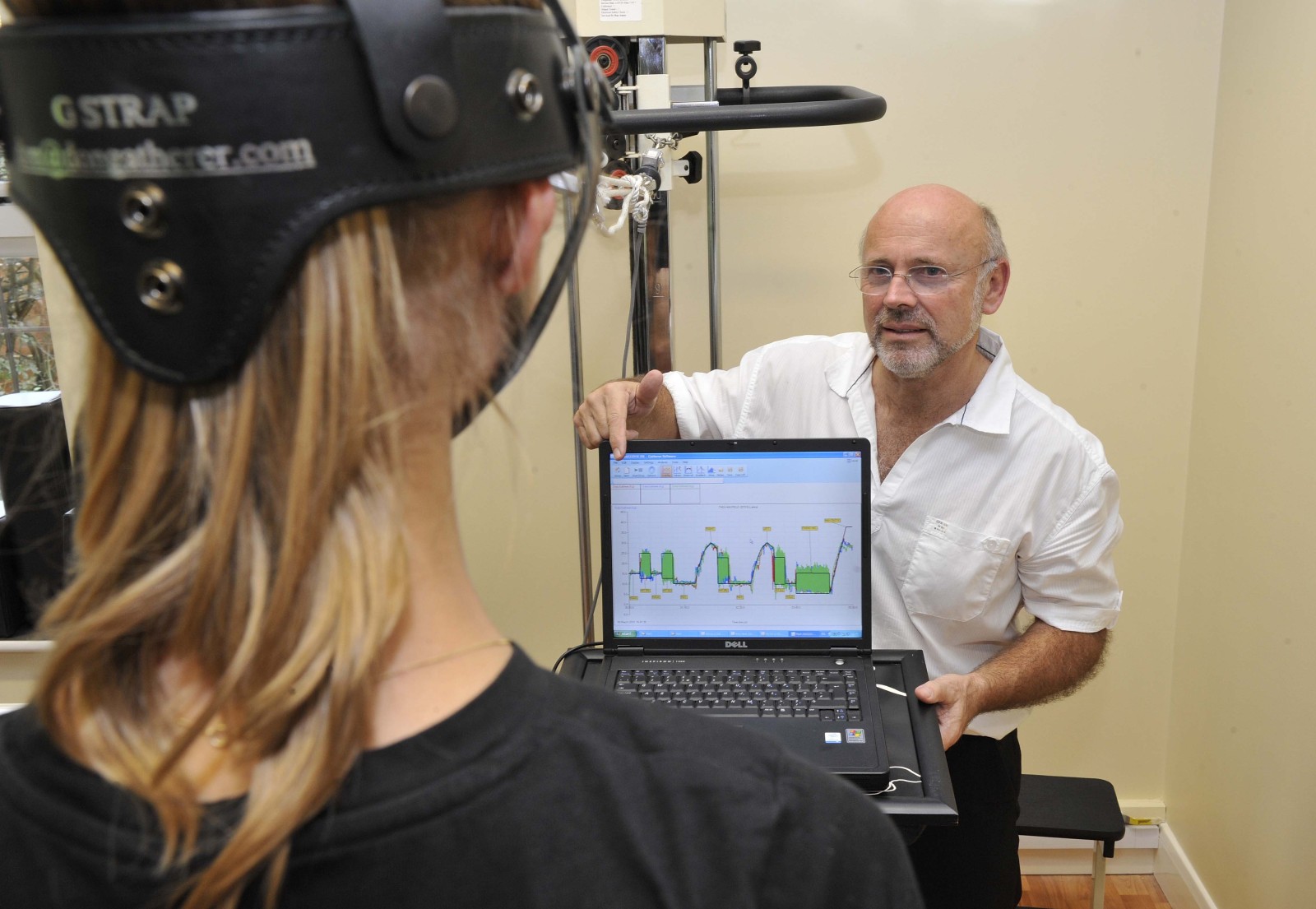Naked Engineering - Measuring Physiotherapy Success
Interview with
Kat - When muscles are injured or weakened, patients are usually referred to a physiotherapist for help, regaining their strength or improving their range of movement. But it can be difficult for the physio to accurately gauge the work load the patient can safely tolerate and the level of improvement that they've made. So now, physiotherapist Don Gatherer, who's previously worked with the England Rugby Team and the British Olympic Squad, has come up with an elegantly simple solution. And for this week's Naked Engineering, Dave and Meera have been along to meet him to find out how it works.
Don - Well the challenge is literally, objective data. A lot of our work is subjective. In other words, you can say, "Hey, how are you feeling? Is it feeling better? Are you stronger?" but we have no measurement for that.
Dave - I guess the other problem is that the human body is incredibly good at adapting to a problem and so, if you've got a problem in one place, it'll do all sorts of strange adaptations to compensate for it.
Don - Yes. That's exactly the case. The body is a really clever piece of engineering.
 Meera - The reason we've come along here today is because you've designed an objective way to calculate just what's going on in our muscles?
Meera - The reason we've come along here today is because you've designed an objective way to calculate just what's going on in our muscles?
Don - Yes. There are instruments out there but they're all fairly big and cumbersome and not portable, so my biggest problem was, how could I design a system that is very easy, portable, and will analyse all the actions very quickly.
Meera - Well you have one of your devices here, so it consists of a harness and a handle with a cylinder attached to it.
Don - Inside that cylinder, we have a load cell and these load cells were developed in F1 and so, I applied that technology to medicine because of the high quality of the load cell that's produced.
Dave - So a load cell is effectively a means of measuring force. It's the sort of thing you get in a set of electronic scales. I guess this is measuring a bit quicker and a bit more accurately.
Meera - And it's measuring the forces of our muscles.
Don - It will measure both the compression and traction forces. So it's a bidirectional load cell.
Meera - To see your device in action, we've also got Thea Maxfield here with us who is a horse rider, but also, Thea, you're a patient of Don's.
Thea - Yes. I came to see Don a year ago after I had an accident where I fell off my horse and I broke the C2 and C3 vertebra in my neck which is commonly called a hangman's fracture.
Meera - So Don, from a physiotherapist perspective then, what was Thea's case when she first came to you?
 Don - Thea had obviously been given the all clear from the surgeon to start looking at exercise programs. So what we needed to do is to find out the objective data analysis of her neck. How strong it was, whether the muscles had wasted, peripheral profile, is there any weaknesses in her arms? So the idea of this is once we know how much force the neck can take, it means that we can then work below that force and apply a load to her neck to strengthen it, but without any risk of injury to the underlying fractures of the spine.
Don - Thea had obviously been given the all clear from the surgeon to start looking at exercise programs. So what we needed to do is to find out the objective data analysis of her neck. How strong it was, whether the muscles had wasted, peripheral profile, is there any weaknesses in her arms? So the idea of this is once we know how much force the neck can take, it means that we can then work below that force and apply a load to her neck to strengthen it, but without any risk of injury to the underlying fractures of the spine.
Meera - So, this is where your device comes in, measuring the forces that the muscles can take before they fatigue.
Don - Well that's it. We measure two types. We measure how strong they are and then we can measure how quickly they can fatigue.
Meera - Well to see how this is possible, Thea is primed and ready. She is sat behind one of your examination couches here. So how would you measure these forces?
Don - Yes. What we're going to do is connect the harness up to the load cell and then we're going to apply the harness to Thea's neck.
Meera - So her head's really encased in this harness and then there are two strings coming out to which the load cell is attached and you're holding the handle of this load cell.
Don - Yes. The two strings are really important because they're connected through a pulley and what this does is equalise the force on either side of the head so we don't get any shear or rotational forces during our analysis. What we do is position Thea into the correct position of the neck and then we apply a controlled force, and she'll hold that force. The test will continue until she loses her position. The moment she loses her position, we stop the test.
Thea - He's trying to pull my head forwards and what my job is, is to keep resisting against it and keep my neck and my head upright, and I can only do that so long as my muscles can manage it, and then I give, and I lean forwards.
 Don - Okay. Here we go. Right, hold, hold, good girl. And there we go. That's fine.
Don - Okay. Here we go. Right, hold, hold, good girl. And there we go. That's fine.
Meera - Thea, you looked quite strained there.
Thea - Yeah, it is quite physically demanding.
Meera - Don, how is this translating then? We've got a big screen behind us and you've selected for the muscles in Thea's neck to be analysed. So what are we looking at on this graph here?
Don - We have the graph for neck extension, so what's happening is that we tare or zero the load cell, so we have a zero rating, and then as we apply the force, you'll see the readout appear, and it'll measure the force as it's being developed. The moment she loses her position then we stop the force, we can then measure the peak and the area below that force.
Meera - I'm assuming you can test other areas in other muscle groups.
Don - We can test her whole body- shoulder, elbow, hand, fingers, knees, foot, toes - everything, hamstrings...
Meera - How is this all then put together to give Thea and other patients a treatment program?
Don - We'll now have a profile of the actions that were tested which means that we can then apply a safe load, whether that would be a stimulatory load for strength or endurance, and we can achieve our physiological goals because we know that we can apply that particular force but in a safe way. We won't fatigue the muscle, we won't then cause undue shearing forces like across her spine, which could irritate underlying structures like the spinal nerve, and so on.
Meera - So how would you summarise the real benefit of this system and this way of measurement?
Don - It is down in simple terms to objective analysis. We take the readings, we can use those readings and then from there, you can database, you can design training programs, but you can also look to see at your clinical effectiveness, if they are improving, if they're not improving, and then you can redesign your testing program. It all bases down to objective analysis.
Kat - That was Don Gatherer from the Gatherer Partnership and his patient, The very willing Thea Maxfield, talking with Meera Senthilingam and Dave Ansell about his new device to help physiotherapist to identify particular muscle groups in a patient that might be weaker. Particularly maybe on one side or the other so they can get special attention, workout what load they need, and workout if they've made any improvement.
References
- Previous Scanning for Osteoporosis
- Next Fact Impact - The Milky Way










Comments
Add a comment